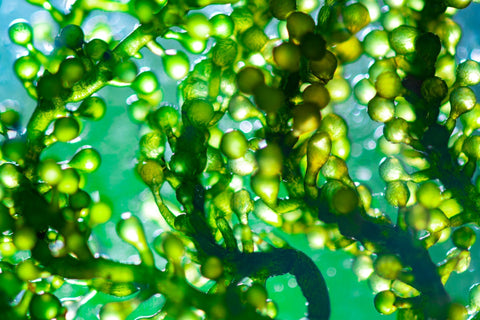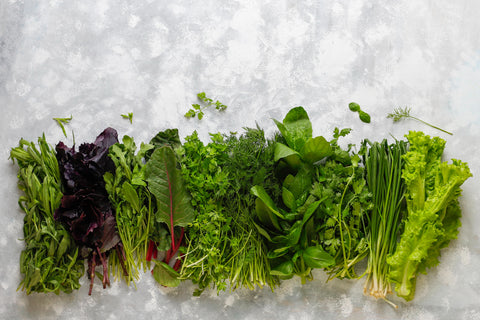Chlorella is a microscopic single-cell freshwater algae which have been found in numerous studies to be a health-promoting superfood.
It is extremely high in chlorophyll, which helps our body to process more oxygen, boosting energy, detoxifying our blood and promoting the repair of tissues.
One of the notable characteristics of chlorella is its high nutritional content. It is considered a superfood because it is densely packed with essential nutrients, including vitamins, minerals, proteins, and antioxidants.
Chlorella is an excellent source of vitamins such as Vitamin A, Vitamin C, Vitamin E, and B Vitamins. It also contains minerals like Iron, Magnesium and Zinc. Moreover, chlorella is rich in protein, comprising all essential amino acids, making it a complete protein source for vegetarians and vegans.
According to Roman Sasik, Ph.D. “Chlorella is a single-cell water organism that acquired a superfood status because of its essential amino acids and high omega-3 fatty acids DHA and EPA content.
It has also been reported to lower blood pressure, lower cholesterol, boost immunity, and fight cancer.”

Nutrient Content
Although chlorella contains less beta-carotene and protein than spirulina, it has more essential fatty acids and is twice as high in nucleic acid and chlorophyll.
Chlorella contains more chlorophyll per gram than any plant, about ten times more than alfalfa and green leafy vegetables and five times more than wheat grass.
It is also a good source of natural iron, iodine, many vitamins and minerals, amino acids, phytonutrients and essential fatty acids.
Health Benefits
According to the Journal of Medicinal Food, researchers from Kyoto, Japan, intake resulted in weight loss and a reduction in fasting blood glucose levels and total cholesterol.
Some studies have shown that chlorella supplementation may help reduce total cholesterol, LDL cholesterol (often referred to as "bad" cholesterol), and triglyceride levels. These effects, combined with its antioxidant properties, make chlorella a potential ally in maintaining heart health.
It helps repair our nerve tissues, enhancing our ability to focus and concentrate. It is a great immune booster as it helps the body produce more stem cells, which can be used to destroy bacteria and viruses.
A 1989 study conducted by the Czechoslovak Academy of Sciences revealed that Chlorella increased the production of spleen stem cells and bone marrow, improving the functioning of the human immune system.
Chlorella has very high levels of DNA and RNA, which help regulate gene activity, cellular function and detoxification and is very effective in slowing the ageing process.
Used regularly, it may assist in the repair of damaged cells and protect our health.
It assists in reducing the risk of high blood pressure, accelerates wound healing, and lowers cholesterol levels. Chlorella balances the body’s pH levels, improves digestion, and reduces radioactive damage.
Furthermore, chlorella may have beneficial effects on digestion and gut health. It contains dietary fiber that can support regular bowel movements and promote a healthy digestive system.
It improves bowel function by stimulating friendly bacteria. Chlorella is regarded as the best food for friendly and health-promoting probiotic bacteria in our gut.
Studies in Japan have shown it helps reduce bad cholesterol, hypertension, and body fat.
Toxins
Chlorella has gained attention for its potential detoxification properties. It is known to have a strong affinity for heavy metals, such as mercury, lead, and cadmium, and may help to eliminate them from the body.
Some studies have suggested that chlorella supplementation may aid in the removal of heavy metals and other toxins, contributing to overall detoxification.
When our RNA and DNA can function most efficiently, our bodies get rid of toxins and avoid disease.
When Dr Benjamin Frank treated his patients with (mercury-free) sardines and other foods high in DNA and RNA, they looked and felt much younger, improved their memory and concentration, and recovered from different health problems, including depression and arthritis.
However, today regular fish consumption (including fish oil) is not a good idea due to the high levels of mercury, lead and other heavy metals present in fish.
For this reason, it is much better to use Chlorella as it binds to mercury and other toxins, removing them from our body and has approximately five times more RNA than canned sardines, making it an ideal anti-ageing food.
Chlorella is an excellent replacement for detox diets, that eliminates many poisons in the body, including heavy metals and pesticides.
It binds to contaminated particles flushing them out of the body, and it is very effective in detoxifying our body from mercury, which is very important as most of us may be contaminated with mercury through dental fillings, vaccination, or fish consumption.
Chlorella is also able to help us detoxify our body from aluminium and fluoride.
Somehow Chlorella seems to “know” which metals are beneficial and which need to be removed, and it does not bind to beneficial minerals like magnesium or zinc.
Chlorella safely absorbs toxic metals present in our colon. It has the unique ability to bind to lead and cadmium.
350 participants took part in a three-year study, which tested more than 20 natural detoxifiers (that were used to remove heavy metals). The study included people who were exposed to very high levels of four main metals, mercury, lead, cadmium and arsenic.
The trial using chlorella eliminated ALL heavy metals, including mercury! With no reported side effects!
History
Chlorella is one of the most widely used natural supplements in Japan, 10 million people use it regularly. In Japan, it is more widespread and popular than vitamin C in North America and Europe.
Studies demonstrated Chlorella helps maintain healthy blood glucose levels and repair damage caused by radiation.
Growth Factor
Chlorella growth factor (CGF) enables it to multiply every 20 hours, making its growth rate faster than any food crop on earth.
CGF promotes normal cell growth without promoting the growth of cancer cells. In addition, it also increases the activity of cells in the human immune system (T and B-cells), which fight viruses or cancer cells.
Iodine Deficiency
Regular intake is also an excellent solution to iodine deficiency, a common problem today (due to soil depletion). It is much safer to use natural forms of iodine, found in chlorella, spirulina, kelp or plant foods as it shouldn’t lead to any harmful side effects.
Taking too much potassium iodide, on the other hand, can lead to thyrotoxicosis (overactive thyroid).
Side Effects
Although no known side effects have been discovered, due to the detoxification and colon cleansing process, you may experience some temporary side effects such as bloating, gas, itchy skin, problems with falling asleep, excitement or feelings of restlessness.
While taking chlorella remember to increase your water intake to 3 times a day, 2-3 glasses between meals.
If you experience sleeping problems due to chlorella’s energy-boosting abilities, I suggest taking it before breakfast.
Chlorella is available in various forms, including tablets, capsules, powders, and liquid extracts. The appropriate dosage can vary depending on factors such as age, health condition, and desired outcomes, so it's important to follow the recommended guidelines or seek guidance from a healthcare professional.
There are many sources and types of Chlorella available, so make sure you buy from a reliable manufacturer such as HealthAid, where it is regularly tested to ensure it is free from contamination.
Related Articles
- Key Nutritional Supplements to Help Slow the Ageing Process and Increa | HealthAid
- Vitamin B12 (cobalamin) deficiency: Symptoms, causes, and treatments | HealthAid
- Feel Tired - Effective Ways to Cope with Tiredness | HealthAid
Sources
1. http://www.greenmedinfo.com/substance/chlorella-algae
2. Sasik, Roman (19 January 2012). “Trojan horses of Chlorella ‘superfood'”. Robb Wolf.
3. Ben-Basset,D.; Mayer, A.M.: Reduction of mercury chloride by chlorella: Evidence for a reducing factor. Physiol. Pl., 40, 157-162, 1977.
4. Wilkinson, S.C.; Goulding, K.H.; Robinson, P.K. Mercury removal by immobilised Algae (Chlorella) in batch culture systems. Journal of Applied Phycology, 2: 223-230, 1990.
5. Kojima, M.; Kasajima, t.; Imai, Y., et al: A new chlorella polysaccharide and its accelerating effect on the phagocytic activity of the reticuloendothelial system. Recent Adv. Res., 13, 11, 1973
6. Merchant, R.E.; Rice, C.C.; Young, H.F.: Dietary chlorella pyrenoidosa for patients with malignant glioma: Effects on immunocompetence, quality of life, and survival. Phytotherapy Research, Vol. 4, No. 6, 220-230, 1990.
7. Ibusuki, K.; Minamishima, Y.: Effect of chlorella vulgaris extracts on murine cytomegalovirus infections. Nat. Immun. Cell Growth Regul., 9: 121-128, 1990.
8. Kanazawa Medical College Dept. of Serology: Effects of various preparations made from chlorella pyrenoidosa cells on the defence mechanism (immune Resistance), 66-70, 1980.
9. Komiyama, K.: Hirokawa, Y.; Mocota, T., et al: An acidic polysaccharide chlon A, from chlorella pyrenoidosa. Anti-tumour activity and immunological response, Chemotherapy, 34: 302-307, 1986.
10. Konishi, F.; Tanaka, K. ; Himeno, K., et al: Anti-tumour effect induced by a hot water extract of chlorella vulgaris: Resistance to meth-A tumour growth mediated by CE-induced polymorphonuclear leucocytes. Cancer Immunology and Immunotheraphy, 19: 73-78, 1985.
11. Kuniaki, T.; Yoshifumi, T.; Tsuruta, M. et al: Oral administration of chlorella vulgaris augments concomitant anti-tumour immunity. Immuno-pharmacology and Immunotoxicology, 12 (2): 277-291, 1990.
12. Miyazawa, Y.; Murayama, T.; Ooya, N. et al: Immunomodulation by unicellular green algae (chlorella pyrenoidosa) in tumour-bearing mice. Journal of Ethnopharmacology, 24, 135-146, 1988.
13. Morita, K., Matsueda T., Iida, T., Hasegawa, T.: Chlorella accelerates dioxin excretion in rats. Journal of nutrition 129 (9): 1731-6, 1999
14. Kunimasa M., Masahiro O., Hasegawa, T.: Chlorophyll derived from chlorella inhibits dioxin absorption from the gastrointestinal tract and accelerates dioxin excretion in rats. Environmental Health Perspectives 109: 289, 2001
15. Merchant, R., Andre, C.: A review of recent clinical trials of the nutritional supplement chlorella pyrenoidosa in the treatment of fibromyalgia, hypertension, and ulcerative colitis. Alternative Therapies 7: 79, 2001
16. Japan Food Research Laboratories, Analysis Certificate No. 100021448-010, 2000
17. Travesio, L./ Canizares, R.O.: Heavy metal removal by microalgae. Bull. Environ. Contam. Toxicol 62: 144-151, 1999
18. Urey, J.C., et al.: Bioconcentration of four pure PCB Isomers by chlorella pyrenoidosa. Bull. Envir. Contam. Toxicol 16: 81-85, 1976
19. Tamiya, N., et al.: Preliminary experiments in the use of chlorella as human food. Food Technology Vol. VIII, 4: 179-182, 1954
20. Hagino et al.: Effect of chlorella on fecal and urinary cadmium excretion in Itai-itai. Jap. J. Hyg. 30: 77, 4/1975
21. Mündliche Mitteilung während der 3rd International Exhibition & Conference of Vitafoods International, 03.-05.05.2000 in Genf, Schweiz
22. Isidori, A., et al.: A study of human growth hormone (HGH) release in man after oral administration of amino acids. Current-Medical Research and Opinion, 7, 1981
23. Fried, R./ Merrel, W.C.: The arginine solution, New York: Warner Books, 1999
24. Lombard, J./ Germano, C.: The brain wellness plan, New York: Kensington Publishing, 1997
25. Kojima, M./ Shishido, K., et al.: A clorella polysaccharide as a factor stimulating RES activity. J. reticuloendothel Soc., 14(2): 192-208, 1973
26. Kojima, M./ Kasajima, Y.: A new chlorella polysaccharide and its accelerating effect on the phagozytose activity of the reticuloendothelial system. Recent Adv. R.E.S., 13: 11, 1973
27. Matusiak, K./ Krzywicka, A.: Influence of the extraction of chlorella vulgaris on growth of fungi. Acta Microbiologica Polonica Ser. B, 7(24), No.1: 51-54, 1975
28. Economics Club: Latest report on functional study of chlorella. Nihonbashi, Japan (unveröffentlicht), 25.06.1997
29. Yasukawa, K./ Akihisa, T., et al.: Inhibitory effects of sterols isolated from chlorella vulgaris on 12-0-Tetradecanoylphorbol-13-acetate-induced inflammation and tumor promotion in mouse skin. Biol. Pharm. Bull. 19(4): 573-576, 1996
30. Vortrag von Dr. Tahao Iida (Health Ecology Research Lab., Fukoka, Japan [July 9-10th, 1998]: Chlorella has remarkable effects of excreting dioxin out of the body. Sonderdruck aus Health Life Business Magazine 179, 1998
31. Jensen, B.: Chlorella, Jewel of the Far East. Escondido/CA, USA: Bernard Jensen Publisher, 1992
32. Singh, A./ Singh, S.P., et al.: Inhibitory potential of chlorella vulgaris (E-2S) on mouse skin papillomagenesis and xenobiotic detoxicartion system. Anticancer Research, 19: 1887-1892, 1999
33. Horikoshi, T./ Nakajima, A., et al.: Uptake of uranium by various cell fractions of chlorella vulgaris. Radioisotopes 28: 485-488, 1979
34. Tanaka, K./ Yamada, A./ Noda, K., et al.: A novel glycoprotein obtained from chlorella vulgaris strain CK22 shows antimetastatic immunopotentiation. Cancer Immunol. Immunother. 45: 313-320, 1998
35. Konishi, F./ Mitsuyama, M./ Okuda, M., et al.: Protective effect of an acidic glycoprotein obtained from culture of chlorella vulgaris against myelosuppression by 5-fluorouracil. Cancer Immunol. Immunother., 42: 268-274, 1996
36. Noda, K./ Tanaka, K., et al.: A water-soluble antitumor glycoprotein from chlorella vulgaris. Planta medica, 62: 423-426, 1996
37. Fujimaki, M., et al.: About C.G.F., Effects on actions of chlorella cell itself, Tokyo, Japan: People’s scientific Research Center at Koganei (unveröffentlichter Bericht)
38. Hasegewa, T./ Okuda, M./ Makino, M., et al.: Hot water extracts of chlorella vulgaris reduce opportunistic infection with listeria monocytogenes in C57BL/6 mice infected with LP-BM5 murine leukaemia viruses. Inter. J. of Immunopharmacology, 17(6): 505-512, 1995
39. Lee, W.H./ Rosenbaum, M.: Chlorella – The sun-powered supernutrient and dits benefiial properties. A good Health Guide, New Canaan, Connecticut: Keats Publishing, 1987
40. Yamagishi, Y., et al.: School children’s growth and the value of chlorophyll. Nihon Iji Shimpo, S. 2196, 1961 (in japanischer Sprache)
41. Tokuyasu, M.: Examples of diets for infants’ and children’s nutritional guidance, and their effects of adding chlorella and C.G.F. to food schedule. Totori City, Japan: Comference proceedings at the nutritional Illness Counseling Clinic 1983, siehe auch: Jpn. J. Nutr. 41(5): 275-283, (1980 u.) 1983
42. Harmann, D.: Free radical involvement in aging. Pathophysiology and therapeutic implications. Drugs Aging, 3(1): 60-80, 1993
43. Siehe Pauling, L.: Pauling’s Vitamin-Programm. München: Bertelsmann Verlag, 1990
44. Konishi, F./ Tanaka, K., et al.: Enhanced resistance against Escherichia coli infection by subcutaneous administration of hot-water extract of chlorella vulgrais in cyclophosphamide-treated mice. Cancer Immunology Immunotherapy, 32(1): 1-7, 1990
45. Hasegawa, T./ ito, K., et al.: Oral administration of hot water of chlorella vulgaris reduces IgE production against milk casein in mice. International Journal of Immunopharmacology, 21(5): 311-323, 1999
46. Tanaka, K./ Yamada, A./ Noda, K., et al.: Oral administration of a unicellular green algae, chlorella vulgaris, prevents stress-induced ulcer. Planta medica, (63): 465-466, 1997
47. Volesky, B.: Biosorption of heavy metals. CRC Press, Florida: Boca Raton, 1990
Any information or product suggested on this website is not intended to diagnose, treat, cure or prevent any medical condition. Never disregard medical advice or delay in seeking it because of something you have read on this website. Consult your primary healthcare physician before using any supplements or making any changes to your regime.






